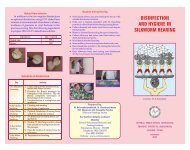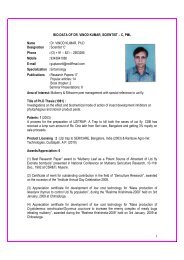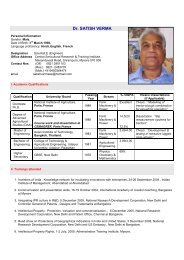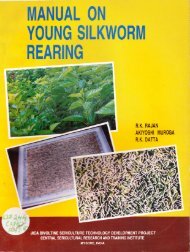Silkworm
A Treatise on the Acid Treatment of Silkworm Eggs - Central ...
A Treatise on the Acid Treatment of Silkworm Eggs - Central ...
Create successful ePaper yourself
Turn your PDF publications into a flip-book with our unique Google optimized e-Paper software.
esterase-A. This suggestion is likely, because as time duration of 30 minutes would be too short to<br />
synthesize de novo the enzyme protein to exhibil the enzyme activity. lt is also possible due to an<br />
intramolecular modification o{ the enzyme itself.<br />
Thus it can be summed up that acid treatment would cause a latent enzyme in diapause eggs to sbt<br />
in motion. lt is quite obvious that eslerase-A activity is correlated with an active resumption ol morphogenesis.<br />
c. Changes in Amino Acid Pools<br />
The concentration of most amino acids in acid treated eggs will not change during development but<br />
the levelof arginine and phosphoethanolamine (PEA) decreases quantitatively untilthe time of hatching.<br />
The fall in the level is very significant.<br />
Ammonia concentration remains low during lhe entire period with only a slight increase alter hatching.<br />
Aspargine remains at a constant low level, while aspartate decreases. Aspartate decreases abruptly<br />
after HCltreatment and then remains low. The developmental changes in aspargine and ammonium are<br />
similar to those in untreated diapause eggs, but there is a marked diff erence in the changes in Aspargine<br />
in HCltreated and untreated eggs.<br />
The changes in glutamate, glutamine and proline in HCltreated eggs are very different from those<br />
in untreated eggs. The levelof glutamate decreases slowly during development, while that of glutamine<br />
increases. The concentration of glutamine is increased by HCI treatment, but that of glutamate is not.<br />
Proline in the HCI treated eggs increases rapidly to a maximum by tifth day and then decreases rapidly,<br />
this change being quite unlike that in normal diapause eggs.<br />
Developmental changes in the concentrations of free amino acids in HCI treated eggs are similar to<br />
those in untreated eggs after resumption of embryogenesis. lt is interesting that in HCI treated eggs,<br />
proline accumulates just after HCltreatment and decreases at the time when the synthesis of cytochrome-C<br />
begins, suggesting that proline is an energy source with high energy efficiency of a lipid with easy<br />
transportation, for development of the silkworm embryos. The decrease in amino acid levels during late<br />
developmental stages of HCltreated eggs and of untreated eggs after diapause indicate active synthesis<br />
of protein during embryogenesis.<br />
When embryogenesis proceeds in silkworm eggs i.e., after diapause ol untreated eggs and in HCI<br />
treated eggs, the concentration of phospho-ethanolamine decreases rapidly suggesting the imporlance<br />
of phospholipid formation for embryogenesis or the importance of phosphoethanolamine either as a<br />
precursor of other metabolic products or as an energy source.<br />
d. Pigment Formation<br />
Diapause eggs immediately after oviposition and till the germband formation i.e. upto 24 hours have<br />
yellow colour. However, after a certain period of development, they gradually turn to brownish black or<br />
blackish brown colour due to the appearance of a specilic pigment known as Ommochrome. This pigrnent<br />
spreads in the serosal cells and manifests the colour. Non-diapause eggs lack this pigment and hence,<br />
the light yellow colour.<br />
Ommochrome is synthesized from Tryptophan through Kynurenine and 3-hydroxy-kynurenine<br />
(3-OHKyn). The pigment precursor3-OH Kyn is synthesized in developing ovaries and othertissues such<br />
as fat body and the ovaries take up this substance from the haemolymph while also synthesizing it during<br />
pupal adult development.<br />
Hence even after acid treatment, the pigment colour is manilested and the eggs acquire a colour.<br />
The colour is rather deep in diapause established eggs in comparison to the treated diapausing eggs.<br />
CHANGES ASSOCIATED WITH CARBOHYDRATE METABOLOSM<br />
Carbohydrate content is intimately related to the physiological event, diapause. Glycolysis as well<br />
as pentose phosphate pathway is understood to operate du'ring glycogen conversion to polyols upon<br />
diapause initiation.<br />
JI




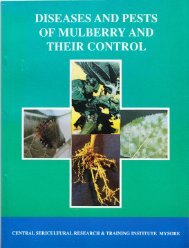

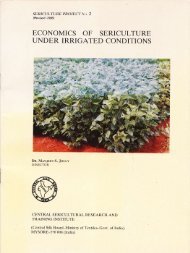
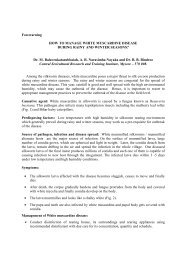
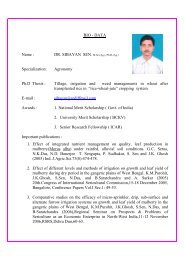
![E}A]\GALORE](https://img.yumpu.com/54052619/1/190x260/eagalore.jpg?quality=85)
